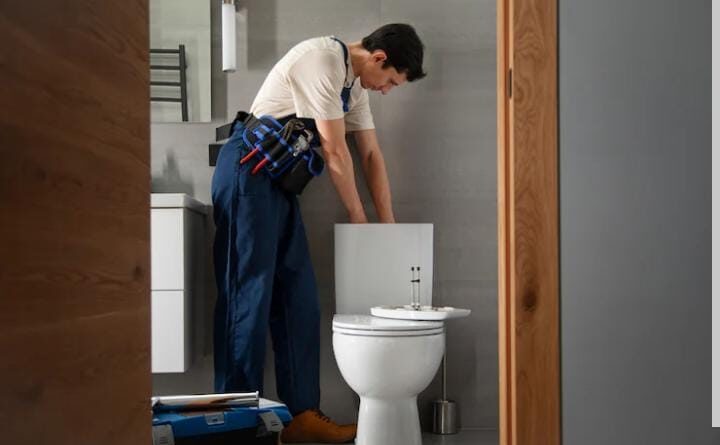How to Unblock a Toilet – Easy and Fast Ways to Fix a Clogged Toilet at Home
Introduction
There’s nothing more frustrating than finding your toilet won’t flush properly. Whether it’s caused by too much toilet paper, a stubborn blockage, or an unknown clog deep in the drain, it can ruin your day in seconds. Luckily, learning how to unblock a toilet doesn’t require special plumbing skills — just the right tools and a little patience.
This guide will walk you through step-by-step methods to unblock a toilet easily, using both traditional and eco-friendly techniques. From using a plunger to natural solutions like baking soda and vinegar, you’ll find simple ways to fix the problem fast and avoid calling a plumber. Let’s dive into how to make your toilet work smoothly again!
H2: Why Toilets Get Blocked
Understanding why blockages happen is the first step to fixing them. Common causes include:
- Too much toilet paper: Overloading the toilet with paper prevents proper flushing.
- Flushing non-flushable items: Things like wipes, sanitary products, and cotton pads cause serious clogs.
- Low water pressure: If there isn’t enough pressure, waste doesn’t flush away completely.
- Hard water buildup: Minerals from hard water can narrow pipes over time.
Once you know the cause, it becomes easier to decide which unblocking method to use.
H2: How to Unblock a Toilet – Step-by-Step Methods
H3: 1. Try the Hot Water Method
Before using any tools, start with the simplest trick.
- Boil a kettle of water, but let it cool slightly (not boiling hot, to avoid damaging the porcelain).
- Pour it slowly into the toilet bowl from waist height.
- Wait 10–15 minutes, then try flushing.
This often helps dissolve minor blockages caused by tissue buildup.
H3: 2. Use a Plunger (The Classic Fix)
The plunger is your best friend when it comes to how to unblock a toilet.
- Make sure there’s enough water in the bowl to cover the rubber cup.
- Position the plunger over the hole and push gently at first to remove air.
- Then, pump firmly up and down for 20–30 seconds.
- Pull it up quickly to release pressure.
Repeat the process if needed. A few strong plunges often do the trick.
H3: 3. Use Baking Soda and Vinegar
For eco-friendly cleaning, mix one cup of baking soda and two cups of vinegar into the bowl.
- The fizzing reaction helps break down soft blockages.
- Wait 30 minutes to an hour, then flush with hot water.
This natural solution is great for both cleaning and unclogging mild blockages.
H3: 4. Use a Toilet Snake or Wire Hanger
If plunging doesn’t work, try a toilet auger (plumbing snake) or a wire coat hanger.
- Push it gently down the drain until you feel resistance.
- Rotate or twist it to break up the clog.
- Pull it back out and flush again.
This method reaches deeper clogs that simple plunging can’t fix.
H3: 5. Call a Professional Plumber
If none of these methods work, it’s time to call an expert.
Some blockages are caused by issues deeper in the pipe or septic system. A professional plumber has the tools and camera systems to inspect and clear tough clogs safely.
H2: Safety Tips When Unblocking a Toilet
- Always wear rubber gloves to keep your hands clean.
- Avoid using chemical drain cleaners, as they can damage your toilet bowl and pipes.
- Open windows or turn on the fan for ventilation.
- Never use sharp objects that can scratch or crack your toilet.
By following these safety measures, you’ll keep your bathroom both clean and damage-free.
H2: How to Prevent Future Toilet Blockages
H3: 1. Flush Only Toilet Paper and Waste
Avoid flushing wipes, cotton balls, or feminine hygiene products. Even “flushable” wipes can cause clogs over time.
H3: 2. Regular Cleaning
Clean your toilet weekly with mild cleaners and a brush. This prevents buildup that narrows the drain.
H3: 3. Check Water Pressure
If your flush seems weak, adjust or replace the flushing mechanism to improve water flow.
H3: 4. Use Less Toilet Paper
Teach family members to use reasonable amounts of toilet paper and flush twice if necessary.
H2: Common Mistakes to Avoid
- Don’t keep flushing repeatedly when the toilet is blocked — it can overflow.
- Avoid mixing chemical drain cleaners with other substances; they can create harmful fumes.
- Never ignore slow drainage — it’s a sign of a forming clog.
Avoiding these mistakes can save you from expensive repairs and messy situations.
H2: FAQs About How to Unblock a Toilet
H3: Q1. What’s the easiest way to unblock a toilet fast?
The easiest way is using a plunger with hot water. It clears most clogs in a few minutes.
H3: Q2. Can baking soda and vinegar really unblock a toilet?
Yes, it helps dissolve minor blockages naturally and is safe for both your toilet and the environment.
H3: Q3. How can I unblock a toilet without a plunger?
You can use hot water, dish soap, or a wire hanger to loosen the clog.
H3: Q4. Why does my toilet keep blocking?
Frequent blockages may mean your pipes are narrow, or you’re flushing unsuitable items.
H3: Q5. When should I call a plumber?
If the blockage doesn’t clear after several attempts, or water backs up into other drains, call a professional immediately.
Conclusion
Knowing how to unblock a toilet saves you time, stress, and money. Whether it’s a simple paper clog or something stuck deeper down, using the right tools and techniques will get your toilet running smoothly again. Remember, prevention is just as important as fixing — use proper flushing habits and regular cleaning to avoid future issues.
By following these proven steps, you’ll never panic again over a blocked toilet. Take action, stay calm, and keep your bathroom fresh and functional every day!
